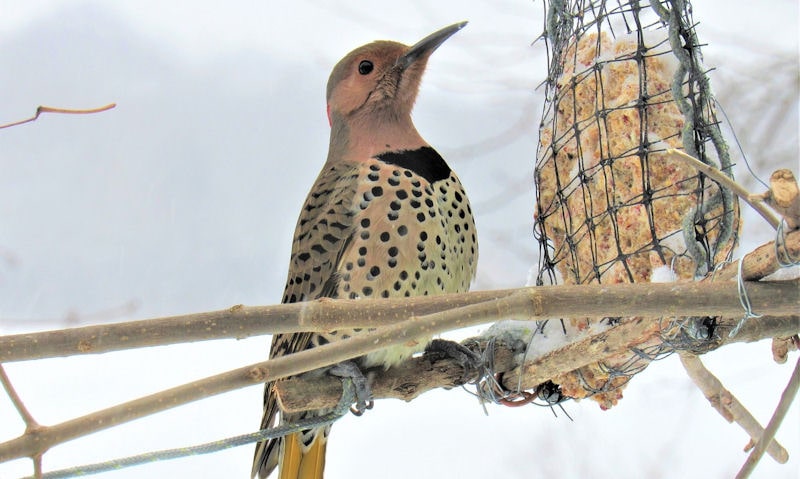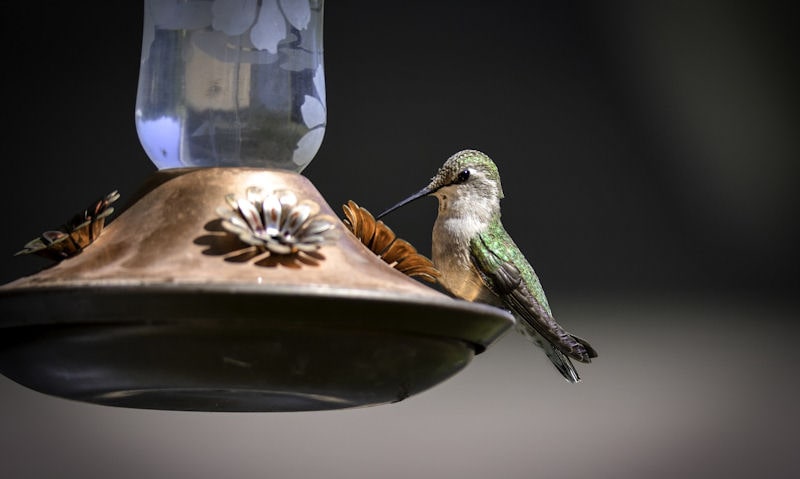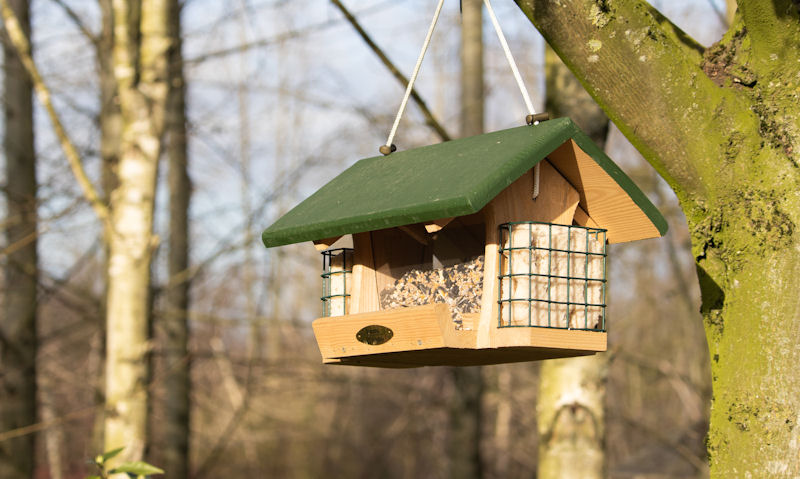Do suet feeders work
With the top bird feeder foods regularly sharing a space on a pole or branch, I will say suet is often left until last, while possibly waiting until the weather is colder.
I can't think of a reason why suet feeders won't work, unless of course your local birds are being stubborn at the time. As a rule, if bird seeds are readily available in seed feeders, birds will wait until its empty before showing interest in suet. With that, suet feeders tend to be hung in a way they're inaccessible.
If you have one or more suet feeders suspended in your yard, they will work if its both visible, yet fully accessible to the wild birds who do eat out suet feeders.
Suet feeders are usually suspended off the bird feeder pole or branch for most of us, when in fact this will mean fewer birds can access this cage-like device, as many birds tend to not have the dexterity to tackle a compact bird feeder like a fat ball or suet cake feeder.
When your suet bird feeder isn't working out for you at this time, it may only take mounting, wedging, and possibly tying the cage to a bracket or branch - to open up what can be a restricting suet feeder, to a wider variety of birds.
I am referring to suet cake or fat ball feeders mind, whereas your upside down suet feeder may see less use, because it mostly caters to Woodpeckers and Chickadees.
How your typical suet feeder works, relies on suet cakes and fat balls being fully exposed to the elements, while being dispensed in a cage which is practically accessible to all wild birds, if its suspended in a way it can cater to all.
Suet bird feeders aren't anything special mind, there's no special tricks or techniques to feed wild birds on a suet feeder, nor is there a special way to attract birds to a suet feeder - other than hanging this type of feeder along with seed and peanut feeders.
In fairness, it can depend on your local birds behavior and the time of year, as birds can prioritize fatty suet in the winter especially, and less in hotter months - even though you can feed birds suet in summer with moderate success.
Hang any type of suet feeder on a bird feeder pole where its tight against the pole, and if hung off a tree branch, just make sure its tightly wedged against a branch grouping.
Hopefully you'll find wild birds will discover your suet feeder in a matter of minutes, because its next to other bird feeders, wild birds frequent regularly all day, and every day.
Work if made accessible
Common misconception of any kind of suet bird feeder, is how it appears to only be used by certain species of wild birds in your yard.
Certainly there's no shortage of Sparrows to Starlings eating suet when they can; while at the same time you may find fewer Cardinals and Blue Jays eating at the suet feeder, and that is for a very good reason.
While your typical Sparrows and Starlings can readily eat suet in any kind of suet bird feeders due to how acrobatic they are - so it doesn't matter how suet bird feeders are displayed in the yard - with your larger Cardinals and much bigger Blue Jays, they usually don't have the space needed to perch on small compact suet cage.
While a suet feeder does work with many common bird feeder birds, its just that when it doesn't ever appear to be used, its could be because it isn't made accessible.
Suet cake bird feeders in particular will benefit more birds if wedged or tied to a pole or branch, rather than allowed to freely hang.
Sure, your large Pileated Woodpecker can feed off a small compact feeder, yet an unstable suet cake feeder like this, would basically be out of bounds for many others.
To be sure you open up your suet feeder of any type to the widest variety of wild birds in your yard: hang the suet feeder so its tight against the bird feeder pole or tree branches, whilst avoid freely hanging a suet feeder because its hard for most birds to access.
No shortage of users
I will say something may be wrong why wild birds in your yard appear to be completely ignoring your suet feeder, and believe me I can't think of any reason why they would - unless of course there's a better variety of wild bird food for now.
What birds eat from suet bird feeders will be among: Cardinals, Jays, Chickadees, Bluebirds, American Robins, Grosbeaks, Finches, Woodpeckers, Starlings, Sparrows, Titmouse, and Nuthatches.
All are widespread across the United States and really are reliable bird feeder birds.
Among them, bear in mind Bluebirds and American Robins can act less agile on freely hanging suet feeders, and like Cardinals or Blue Jays - they like to perch on top of a stabilized suet feeder - rather than clinging awkwardly at an angle.
Remember, suet feeders tend to be void of perches to assist wild birds, and thus wild birds are generally forced to feed in a way they aren't capable of, in case of larger birds.
What this should tell you, there's no shortage of the most common backyard birds in your area, who would normally be allowed to freely eat suet when made accessible.
And while the ingredients in suet cakes or fat balls can cater to individual insect, seed or fruit-eating wild birds, there's usually always a little something for everyone.
Suet feeders delayed
With a suet bird feeder having no reason not to work other than you not making it accessible to the widest variety of wild birds in your yard. Simply put, it could just be that time of year wild birds prioritize only seeds or dried mealworms.
What I have found on my bird feeding station pole, is that wild birds will consume all the bird seeds out of the seed feeders, and only then will they find any interest with my fat balls once they've plundered the seed mixes
It isn't an accessibility or visibility issue because my Sparrows or Finches will eat seeds in small compact, hard to access feeders - yet will ignore the suet the whole time.
Little suet is eaten but I'll find all the wild bird seeds are eaten before these birds and more, will think to take the suet seriously.
I put it down to seeds catering to mostly seed-eating birds in my yard and will continue to eat seeds as necessary.
Suet bird feeders do work for sure but you will find wild birds can prioritize certain bird foods in other bird feeders, while at the same time their dietary needs would mean suet will only be eaten in colder months.
Conclude
Suet bird feeders should work just as seed and peanut feeders do when hung up on a bird feeder pole or tree branch.
One caveat of suet bird feeders in particular, would be wild birds do prioritize more seeds, fruits and nuts in their diet - just as they do in the wild - and with suet being an unusual, unnatural bird food, it can be ignored by most.
What's more, wild birds will be seen to only eat seeds even with everything else on display, which are usually suspended next to seed feeders - simply because seeds are what these birds eat in the wild.
Only when the seeds have been all eaten all up will you possibly find birds having any kind of interest in the suet varieties.
With that, wild birds will eat suet plus the ingredients within it, in winter far more, as this protein rich, fatty suet cake or balls are needed in the cold when birds lose weight.
You see then while suet bird feeders of any kind do really work at various levels of interest, they will be less of a priority when bird seeds are available.
And don't worry about if your backyard birds will eat suet or not - as this is a top five bird feed which is eaten by dozens of wild bird - it just depends on time of year. And of course dietary needs, and if the suet bird feeders are at least accessible to less agile birds, on what is a small compact cage-like feeder.


